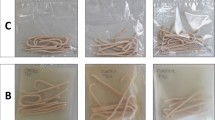Summary
-
1.
Under the highly humid conditions prevailing in Eastern India during the monsoon, storage of gur at this time of the year presents a serious problem as the material is apt to suffer greatly in quality as well as quantity on account of moisture absorption, resulting in inversion and fermentation which gives rise to great deterioration and loss. The country methods of storage in vogue (e.g., inside a blanket of bhusa or wheat straw) gives far from satisfactory results and in these days of acute food shortage the need for evolving an effective storage method must be regarded as a national one, In these investigations, furnace ash and charcoal powder (selected respectively on account of their hygroscopic and adsorptive properties) have been examined with respect to their efficacy as storage blankets against the com-@#@ monlyused storage material, wheat bhusa as also storage under exposed conditions.
-
2.
The experiments bring out the unique performance of furnace ash (from gur furnace) in affording perfect protection from moisture and saving gur under storage from the least deterioration during the rains. The reason for this behaviour obviously lies in the highly hygroscopic nature of ash, by virtue of which property, the material arrests the atmospheric moisture in itself, thus preventing it from reaching the gur stored inside. The utility of furnace ash as storage blanket has been discussed from different standpoints.
-
3.
Experiments on changes in important physical and chemical attributes of gur under different conditions of storage reveal interesting differences in behaviour which lead to definite characteristics in respect of these properties, associated with different stages of deterioration in storage. These are stated here in brief.
Similar content being viewed by others
References
Khanna, K. L., and Sen, S. C.Ind. Jour. Agrl. Sci., 1938,8, 441–46.
Rao, A. N., Kripashankar and Gundu RaoProc. Ind. Sug. Tech. Assoc., 2ndConv., 1933, 62–67.
Report on the marketing of Sugar in India and Burma, Govt. Ind. Marketing Ser. No. 39, 1943, 247–50.
Varahalu, T. “Studies in Sugarcane Jaggery—III. The Empirical Test for the End-point of Boiling in Jaggery Manufacture,”Madras Agric. Jour., 1937,25, 12, 377–82.
— “Studies in Sugarcane Jaggery—IV. Some Properties of Jaggery in Relation to Moisture,” —, 1938,26, 2, 55–65.
— “Studies in Sugarcane Jaggery—V. Macro-structure of Jaggery,” —, 1938,26, 10, 394–98.
-, “Studies in Sugarcane Jaggery (Gur)—VI. Micro-structure of Jaggery,”Proc. Sug. Tech. Assoc. India, 8thConv., 1939, 1–20.
Author information
Authors and Affiliations
Rights and permissions
About this article
Cite this article
Khanna, K.L., Chacravarti, A.S. Studies in storage of Gur—I. Proc. Indian Acad. Sci. 30, 99–119 (1949). https://doi.org/10.1007/BF03051582
Received:
Issue Date:
DOI: https://doi.org/10.1007/BF03051582




